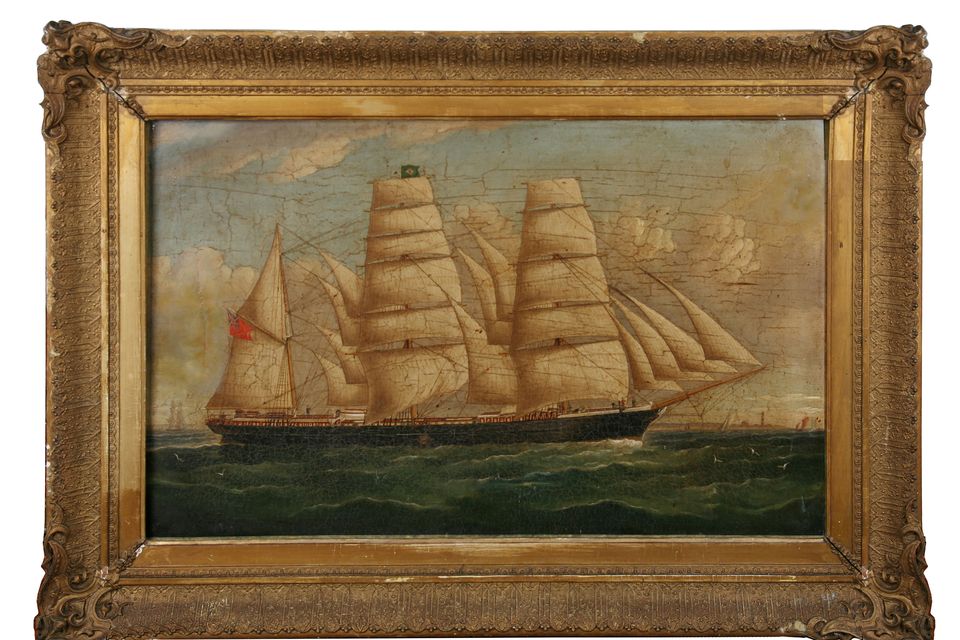
Paintings of two Spaight’s Shipping Company sailing ships come to auction A painting of the Spaight Craigendarroch sailing ship A painting of the Spaight Derry Castle There’s a dark chapter of history behind two paintings in Sheppard’s Legacy of the Big House auction, which takes place in Durrow, Co Laois from September 24 to 26. Both show 19th-century sailing ships owned by Spaight’s Shipping Company in Limerick. The ships are magnificent three-masted vessels in full sail, professionally painted by unknown artists.
One is of the Spaight Craigendarroch , flying the British flag and Spaight shipping flag (70 x 100cm framed); the other is the Spaight Derry Castle (82 x 113cm framed). Paintings of this kind were often commissioned by shipping companies and hung in their offices to impress clients. Both come from a Limerick collection and each is estimated to sell for between €1,500 and €2,500.

Spaight’s Shipping Company was once the hub of Limerick’s substantial shipping industry. The company was owned by Francis Spaight (1790-1861), a landlord and merchant from Co Clare. Spaight and his company are now best known for a grisly and much publicised incident that occurred several decades before these paintings were made.
The sailing ship the Francis Spaight (named for its owner) was returning from Canada with a cargo of timber when it capsized in mid Atlantic in November 1935. Three were drowned. The remaining 15 included four teenage boys.
When the food ran out, the captain suggested that one of these should be sacrificed and eaten to save the rest. The cabin boys were chosen because they had no dependants. The four boys were forced to draw lots and 15-year-old Patrick O’Brien drew the short straw.
He was killed and eaten by the rest of the crew. Over the next few days another cabin boy, George Burns, and an adult sailor, Michael Behane, became deranged from dehydration. They too were killed and cannibalised.
A fourth man who died of natural causes was also eaten. The remaining 11 were rescued and survived. The story was told at the time, amid much controversy.
The ship’s captain Timothy Gorman had followed “the custom of the sea”, an unofficial practise that turned a blind eye on cannibalism at sea when there was no other option. The only person to be prosecuted was Patrick O’Brien’s widowed mother, who made a fuss. A painting of the Spaight Derry Castle In 2022, the story was the subject of a radio documentary The Custom of the Sea by Marc McMenamin and Sarah Blake for RTÉ’s Documentary on One .
The drama of this incident drew attention away from the true business of Spaight’s Shipping Company, which was euphemistically known as “landlord assisted emigration”. Impoverished tenants were seen as an impediment to the improvement of the land and offered a passage to North America or Canada, in return for their homes and farms. In 1847, during the Great Famine, Spaight told the Select Committee on Emigration that emigration was a profitable business “because our ships would otherwise go out [to Canada] in ballast; and the result is that whatever we get in the way of passengers is so much gain to us”.
Passenger conditions were grim. Many died on the voyage or shortly after arrival. But the ships returned with a cargo of timber, which was a win-win for Spaight Passenger conditions were grim.
Many died on the voyage or shortly after arrival. But the ships returned with a cargo of timber, which was a win-win for Spaight. One of the ships in the paintings at Sheppard’s, the Spaight Derry Castl e, was named for Francis Spaight’s 4,500-acre estate on the shores of Lough Derg, which he purchased for £39,500 in 1844 (almost €5m in today’s money).
In 1847, he told the Select Committee on Emigration that he had improved its profitability by evictions having “got rid of all the paupers from the Derry Estate”. When Francis Spaight died in 1861, the ships of Limerick port flew their flags at half-mast. The family firm was passed down to his sons and continued into the twentieth century.
The Spaight Derry Castle was an ill-fated vessel. In 1887, she was wrecked on Enderby Island, off New Zealand. Fifteen were drowned, including the captain, but seven were washed ashore.
The barren island had little to offer but nobody got eaten. They were rescued four months after the shipwreck. Other pieces of maritime interest in the sale include an ebony and ivory octant, a navigational device, made by Henry Hunt of Cork (est.
€400 to €600). There are also: a collection of taxidermy pheasants (est. €3,000 to €5,000); an 18th-century Italian giltwood console table (est.
€3,000 to €5,000); and a 1984 Rolls Royce Silver Spirit (est. €20,000 to €30,000). See sheppards.
ie Join the Irish Independent WhatsApp channel Stay up to date with all the latest news.














